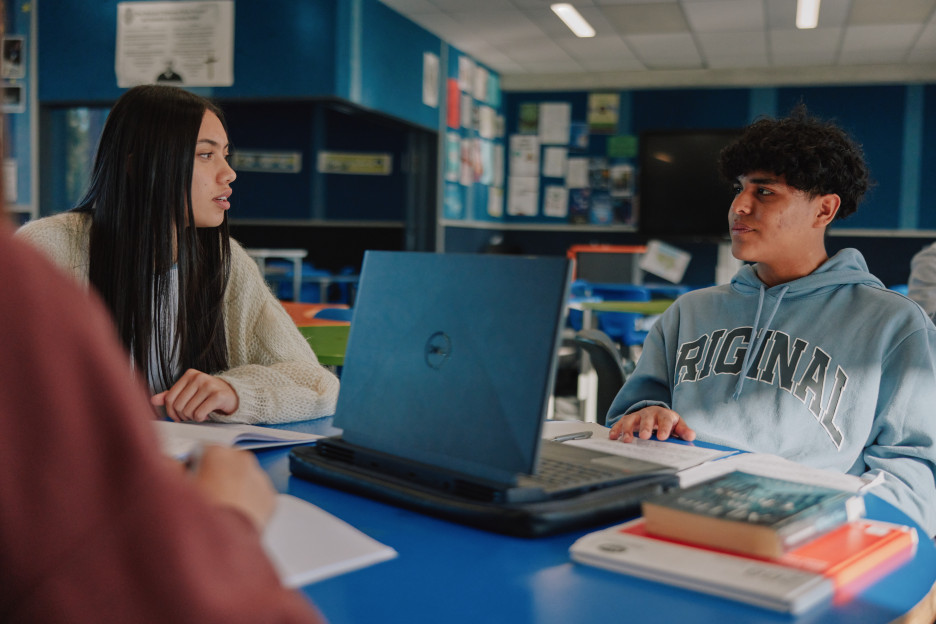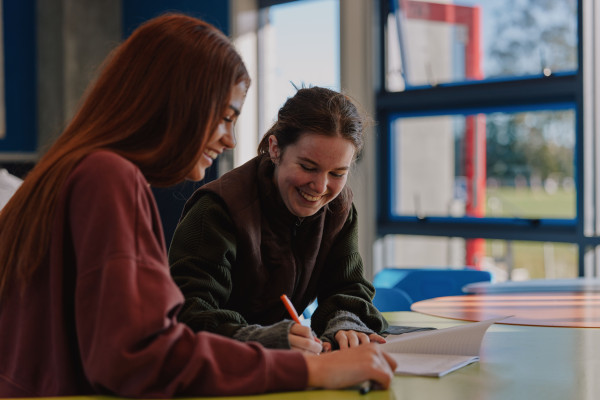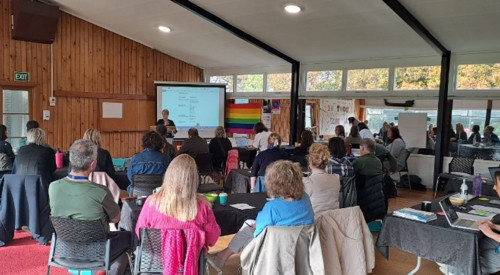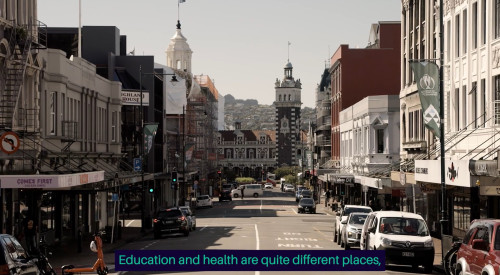Healthy insights: How understanding youth health trends can help schools better support students
Evidence 15 May 2023

Schools are centrepieces of young people’s daily lives. At their best, they serve as places where students feel safe, supported, and able to be their authentic selves.
As young people transition to adulthood, multiple developmental changes occur, some of which can be challenging to navigate. During this often difficult time of life, rangatahi must simultaneously navigate difficult decisions relating to their education, intimate relationships, and health, including whether to try substances.
Research shows that healthy, supportive school environments can help young people thrive and protect them from various harms. Teachers and other school staff play vital roles in this. To offer meaningful support however, schools must understand the challenges and pressures that young New Zealanders are dealing with.
By drawing on data and insights from the likes of the Youth19 and ASH Year 10 surveys, schools can start to better understand the reality of the issues young people are facing in Aotearoa, as well as the supportive role they can play in improving health outcomes for their students.
What is the Youth19 survey?
The Youth2000 survey series investigates trends in young New Zealanders’ health and wellbeing and is carried out by researchers from four New Zealand universities. In the most recent of these surveys, conducted in 2019, 7900 young people aged 12–18 in Auckland, Northland and Waikato responded to a 45-minute online questionnaire.
The survey covers physical and sexual health, rates of substance use, school experiences, spirituality and access to healthcare, among other topics. Results are used to inform education, health and social services and programmes for young people.

When schools accurately understand what young people are facing, they can better support their students
While Tūturu focusses on all aspects of young people’s wellbeing, the initial focus is on alcohol and other drugs. Below is a snapshot of some of the trends Youth19 identified for young people. We have also drawn data on tobacco and vaping trends from Action on Smoking and Health New Zealand’s (ASH) 2022 survey of year 10 students (13–14-year-olds).
Snapshot of trends in Youth19 data
Alcohol and substance use:
- 60% of those under 16 were not drinking; and overall, secondary students were drinking less frequently than in previous surveys.
- Binge drinking remains high among older secondary school students, with 29% of 16-year-olds and 42% of 17+ year olds engaging in binge drinking in the past month.
- The frequency of alcohol use does not differ markedly by neighbourhood deprivation or gender, but rainbow youth, girls, Māori, Pasifika and those living in deprived areas experienced more harms from alcohol use.
- For the entire cohort, aged between 12-18, using cannabis weekly or more often (4%) has become more common than tobacco smoking (3%)
Snapshot of tobacco use and vaping from ASH's 2022 Year 10 Survey: *
- The number of daily smokers in this cohort is 1.1%. This is the lowest daily smoking rate since the survey began.
- The share of daily vapers is up slightly from 9.6% to 10.1%, however, this is a much smaller increase in the total number of vapers than in previous years.
- The number who regularly smoke is down from 4.2% to 3.0%; the number of regular vapers is also down from 20.2% to 18.2%.
- The share of people who have never tried smoking is up from 82.5% to 85.8% and the number who have ever tried vaping is down (42.7% to 40.1%).
- Māori daily vaping is up (19.1% to 21.7%), particularly Māori girls (21.3% to 25.2%)
- Regular smoking rates are down for Māori, Pacific, European/Pākehā; regular vaping down for European/Pākehā only.
- The share of people who have never tried smoking is up amongst Māori, Pacifika, European/Pākehā. The share who have ever tried vaping is down for Māori, Asian, European/Pākehā.
- The number of daily vapers among the never having tried smoking group is up (3.1% to 4.3%); no change for daily smokers (86.6%).
Find more about ASH's survey here.
* Note: the vaping landscape changes frequently and therefore statistical trends from even a couple of years ago may not necessarily reflect the current environment.
Mental health:
- Indicators of mental health, particularly for minority groups, remain a concern.
- The prevalence of significant depression symptoms nearly doubled between 2012 (13%) and 2019 (23%).
- Since the survey began in 2000, other sources show that teenage pregnancies and STIs have declined, likely due at least in part to reductions in substance use.
- Suicide attempts and ideation have increased since 2012.
Schools and youth:
- School cultures have improved, as young people are more likely to report fair treatment from teachers.
Find out more about the Youth19 here.
Youth19 data clearly shows that school cultures have improved in the five years since 2014, with young people more likely to report fair treatment from their teachers. We also see how important schools are in reducing young people’s substance use.
The rate of binge drinking among older secondary school students remains high compared to similar countries, and the decline in students’ substance use over the last 20 years has stayed stable.
Understanding and addressing these findings
Adolescent Health Research Group Member Dr Jude Ball worked on the Youth19 survey and says teachers and schools have played a key role in reducing substance use by young people.
“There are key environmental factors in a school that make a significant difference to students, such as when young people report that teachers treat them fairly, and this has likely helped reduce substance use and harms. Moreso, it is associated with increased connectedness to the school and sense that teachers care about them.”
As the nature of education has shifted over time, it is now widely understood that when schools support students in their wellbeing, it impacts their academic outcomes. “It’s hard for young people to learn when they are hungry, distressed or traumatised, so the pastoral care role that schools and teachers play is really vital. Holistic support at school means students are less likely to turn to substance use to help them cope, and more likely to succeed academically,” Dr Ball says.
Director of Action for Smokefree Aotearoa 2025, Ben Youdan says ASH data shows that vaping by young people increased significantly during a period when New Zealand had no clear framework for regulation.
“Fortunately, it appears that rate of increase is slowing. It is also important not to confuse use with addiction. The word addiction gets thrown around, and it’s really distracting from the reality that most are experimenting, or infrequent users.”
Although risk taking is a normal part of adolescent development, Ben says ASH had seen no evidence that vaping was a gateway to smoking or other substances in Aotearoa. “Across the range of teenage risk-taking, vaping is actually one of the least risky things they could be doing,” he says.
“Legislation making vaping on school grounds illegal encourages a punitive approach, and we really discourage this. It is important not to take approaches that ostracise the behaviour or the vape. Young people are navigating a world where they will experiment with risky behaviours and need to feel safe to discuss smoking or vaping in this context.”
“There are some who will be dependent on vaping to manage nicotine cravings and withdrawal, but it’s not the majority. For these young people, it’s important not to force them to quit, but to take a supportive approach.”
How high schools can better support their students

Youth19 data shows more students now report fair treatment from their teachers than in the past
A body of research has found educational, fact-based programmes about substance use are ineffective – unless they are part of a whole-of-school, comprehensive and on-going approach to critical learning.
A whole school approach to student wellbeing takes a holistic view of a student's life at school, including the environment, curriculum, teaching, and wider community. This approach aims to promote student wellbeing by aligning and integrating all aspects of the school system. It involves teachers, staff, students, parents, and other stakeholders, working together to support students where needed. It may also involve collaborating with external organisations to identify gaps in support by collaboratively exploring the space between health education and treatment.
“The whole-of-school approach is more effective than one-off events, such as an assembly on vaping,” says Dr Ball. A supportive, health approach is more effective than punishment, and programmes also need to be tailored to the diverse needs of different age groups.
“The vaping issue is really challenging for schools currently. We need better regulation and enforcement by Government to address the problem. But at the school level there’s so much evidence that looking at substance use as a health and social issue, with students needing support, is more effective than a punitive approach.”
Dr Ball says there are no easy answers but punishing and discipline “will make things worse for the individual student and not necessarily solve the problem, since vaping is highly addictive.” Schools need to take this message to their boards, and to communicate with parents.
“It’s about having clear expectations about non-use. That does help. If parents say they don’t want their child to vape or drink, there are better outcomes – much better than saying, ‘Do whatever you’re going to do, you’re going to do it anyway.’”
“It’s a bit of a misconception that students will do the opposite of what you tell them. Clear expectations around behaviour are good, and then restorative approaches – firm but fair – when the kid gets it wrong, along with support to address addiction or underlying problems. It’s really important to keep communication channels open, to maintain relationships and not give up on kids.” The same applies for health providers, she says.
How Tūturu can help
Tūturu is a modern approach to young people’s wellbeing in Aotearoa that brings together health providers and schools, so they are better equipped to work with and prepare students for the complexities of modern life.
Tūturu aspires for all young people to feel connected to and positive about their school. The approach focuses on four main areas: school climate, pastoral care, professional learning and development and curriculum resources for students years 9-13.
Through Tūturu and other initiatives that encourage a whole-school approaches, schools can create environments where students feel safer and empowered to be their authentic selves. Tūturu focusses on empowering students, teaching them critical thinking and health competencies so that they are equipped with the knowledge and skills needed to make informed choices about their health and wellbeing.
By embracing initiatives like Tūturu, schools can show their commitment to nurturing the holistic development of young New Zealanders, thereby laying a strong foundation for their future success and overall wellbeing. To read more about Tūturu, see here.
Recent news

Supporting Students: A Wellbeing Lens – Dunedin Tūturu Whole School Approach Day 2024
2 July 2024
In May, schools from throughout Otago and staff from orgs such as Te Whatu Ora, NZ Police and MOE gathered to hear from a range of speakers on how best to meet the needs of secondary school students.
How can schools better handle student mental health and wellbeing? Insights from NZCER's secondary principals' survey
25 March 2024
In November 2023, the results of a 2022 nationwide survey of secondary school principals in Aotearoa revealed that the top issue they ranked dealing with at school was providing support for students grappling with mental health or wellbeing issues.

Tūturu in Ōtepoti Dunedin
19 February 2024
Whakaata Tohu Tohu | Mirror Services, works with multiple schools in Ōtepoti.